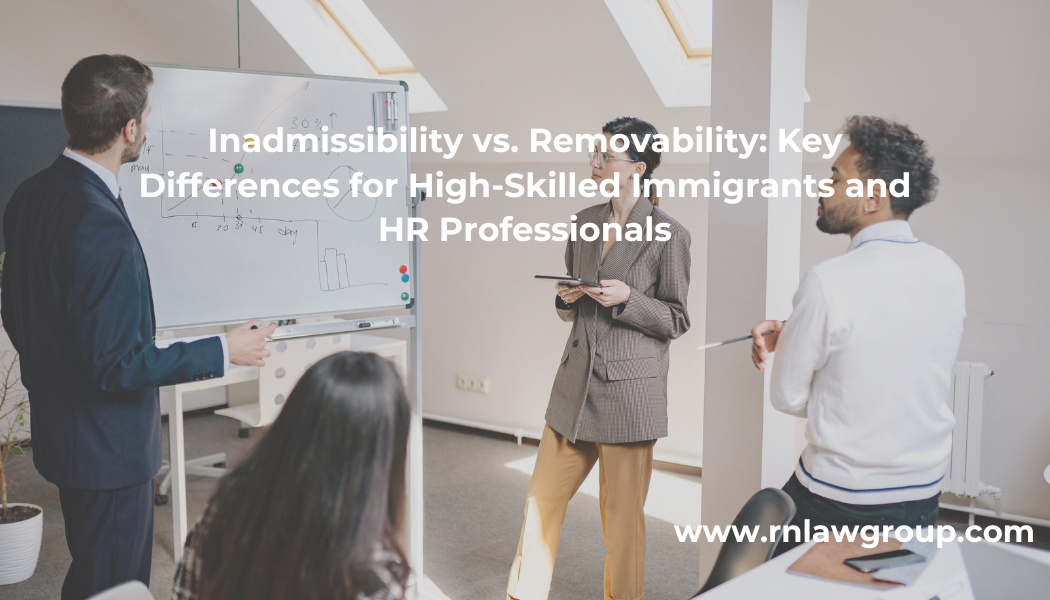
Inadmissibility vs. Removability: Key Differences for High-Skilled Immigrants and HR Professionals
Introduction
Navigating U.S. immigration law can be complex, especially when it comes to understanding the difference between inadmissibility and removability. These two legal concepts determine whether a foreign national can enter or remain in the United States. In simple terms, removability refers to your ability to be deported from the United States after you have been admitted, while inadmissibility impacts your ability to be granted a visa, admitted into the country, or receive an extension or change of status while in the U.S.
Removability focuses on a person’s compliance after entry into the U.S., while inadmissibility involves screening for eligibility before or at the time of entry. A person who is removable has typically done something after admission that violates the law, while an inadmissible person may never even get the chance to enter. The consequences, remedies, and legal proceedings associated with these two determinations vary significantly, and understanding them can help avoid serious immigration setbacks.
While the terms are sometimes used interchangeably in everyday speech, the legal distinctions are important. For years, “removal” has officially replaced the older term “deportation” as the legal framework governing expulsion from the United States. Adjustment of status applicants already in the U.S. can also be found inadmissible, even if they’ve never departed the country.
For high-skilled immigrants – such as H-1B professionals, L-1 transferees, O-1 visa holders, or employment-based green card applicants (EB-1, EB-2, EB-3, EB-5 categories) – and the HR professionals who sponsor them, it’s crucial to grasp how inadmissibility and removability differ. A mistake or misunderstanding could mean a talented employee is denied entry at the consulate, airport, or worse, placed in deportation proceedings.
This article explains what inadmissibility and removability mean, provides clear definitions under U.S. law, and gives practical examples of how these issues might arise for high-skilled workers. It highlights common grounds that trigger each and why the distinction matters for employment-based immigrants. Finally, it compares the processes, consequences, and possible remedies if someone is found inadmissible versus removable and offers tips for employers and employees to avoid these pitfalls.
What Is Inadmissibility?
Inadmissibility means a person is ineligible to be admitted to the United States or to receive a visa under certain statutory grounds. In other words, an individual who is “inadmissible” cannot enter the U.S. or obtain lawful permanent residence (a green card) until that issue is resolved. The rules for inadmissibility are set out in Section 212(a) of the Immigration and Nationality Act (INA), codified at 8 U.S.C. §1182. This law lists many classes of aliens ineligible for visas or admission, including health issues, criminal history, security risks, likelihood of becoming a public charge, fraud/misrepresentation, prior immigration violations, and more.
Inadmissibility applies primarily to people who are seeking admission to the U.S., such as:
- At a port of entry (e.g., arriving at an airport with a visa)
- Entering without inspection
- Applying for an extension or change of status
- Applying for a green card (adjustment of status)
In some cases, inadmissibility may arise from past actions that occurred long before the person sought entry. For example, having a prior visa overstay or criminal record, even years ago, can render someone inadmissible. For this reason, it is critical for both immigrants and their legal representatives to thoroughly assess any potential red flags before applying for a visa or adjustment of status.
Example: Jane is an H-1B professional who once overstayed a tourist visa by 7 months. This makes her inadmissible if she leaves the U.S. and tries to re-enter or apply for a new visa. She would need to address this by obtaining a waiver of inadmissibility or waiting outside the U.S. for three years.
What Is Removability (Deportability)?
Removability refers to the condition of being subject to removal from the United States after having been admitted. If someone is “removable,” it means the U.S. government can deport them because they violated immigration laws or no longer have a legal right to remain. The legal grounds for removability are listed in Section 237(a) of the INA, codified at 8 U.S.C. §1227.
Removability applies to people who have already been admitted to the U.S. (temporarily or permanently), such as:
- Nonimmigrant visa holders who violate their status (though rarely used)
- Lawful Permanent Residents who commit crimes or were ineligible for their green card
- Anyone in the U.S. without status
Unlike inadmissibility, which is typically assessed before or at the time of entry, removability is enforced inside the United States and may involve removal proceedings in immigration court. The government initiates the process by issuing a Notice to Appear (NTA), and the individual has the right to defend themselves against the charges.
Example: John is an L-1A transferee whose employment ends. If he stays in the U.S. more than 60 days without transferring to another status, he could be removable. He could be placed in removal proceedings for being in the U.S. without lawful status.
Example: Jack is a green card holder who is convicted of a crime involving moral turpitude within five years of being admitted as an LPR. Depending on the severity and sentence, he may be considered removable under INA §237 and could face deportation with limited options for relief.
Common Grounds of Inadmissibility (INA §212)
For high-skilled workers, common grounds of inadmissibility include:
- Health-Related Grounds: Communicable diseases or lack of vaccinations. Substance abuse or addiction may also raise issues. This is a common ground for those with DUI arrests in which the consulate investigates more.
- Criminal Grounds: Crimes involving moral turpitude (CIMT), drug offenses, even without a conviction if the person admits to the conduct.
- National Security: Terrorism, espionage, or membership in extremist groups.
- Public Charge: If likely to become primarily dependent on government support. Recent policy shifts have reinstated broader considerations for green card applicants.
- Labor Certification and Employer Requirements: Lack of valid labor certification or bona fide job offer. This predominately refers to the green card side.
- Fraud and Misrepresentation: Willful misrepresentation of a material fact to obtain a visa or green card. This results in a permanent bar without a waiver.
- Prior Immigration Violations: Previous removal, unlawful presence triggering 3- or 10-year bars, or illegal entry.
- Failure to Attend Immigration Proceedings: In absentia removal orders trigger a 5-year bar.
- Lack of Documentation: Entering or seeking a visa without proper documents or a valid passport/visa.
Common Grounds of Removability (INA §237)
Common reasons high-skilled workers become removable include:
- Status Violations: Overstaying a visa, unauthorized employment, or failure to maintain visa conditions.
- Being Inadmissible at Entry: If a person was inadmissible when admitted or adjusted status, they are now removable. This often arises when USCIS later uncovers undisclosed criminal records or fraud.
- Criminal Convictions: CIMTs, aggravated felonies, drug offenses, domestic violence, firearms violations. Aggravated felonies, such as drug trafficking or certain types of fraud, frequently trigger mandatory removal with very limited relief.
- Immigration Fraud: Misrepresentation in obtaining immigration benefits, including fake job offers or credentials.
- Security Grounds: Involvement in terrorism or espionage.
- Public Charge (rarely enforced): While rare, lawful permanent residents (LPRs) can be removed if they become public charges within 5 years of entry due to pre-existing conditions.
- Administrative Violations: Failing to notify USCIS of a change of address or failing to register
Key Differences: Process, Consequences, and Remedies
When Each Applies: Inadmissibility applies when seeking a visa, entry, or change of status, extension of status, or adjustment of status to a green card—including through adjustment of status inside the U.S. Removability applies to those already in the U.S. who violate immigration laws.
Decision Makers: Inadmissibility is determined by consular officers, CBP officers, or USCIS officers. Removability is determined by an immigration judge in removal proceedings.
Consequences:
- Inadmissibility means denial of entry, extension or change of status, visa, or green card.
- Removability can lead to detention, removal, and bars to reentry.
Remedies:
- Waivers for inadmissibility (e.g., 212(d)(3), I-601, or I-601A) may be available depending on the ground and the applicant’s family ties.
- Relief from removal includes adjustment of status, cancellation of removal, asylum, and voluntary departure, which allows individuals to leave the U.S. without a deportation order on record. Most of these would have to be done in removal proceedings
Tips to Avoid Inadmissibility and Removability Problems
- Maintain Status Diligently: Track I-94 expirations, file timely extensions, and stay within authorized work conditions.
- Be Honest and Complete in All Filings: Misrepresentations can permanently bar reentry.
- Disclose Past Legal Issues to an Attorney: Even minor offenses may impact admissibility or deportability.
- Employers Must Maintain Compliance: Follow I-9, LCA, and USCIS reporting requirements. Amend petitions when job details change.
- Prepare Thoroughly for Travel and Visa Interviews: Carry current approval notices and ensure your records are clean.
- Understand Your Rights: If you face inadmissibility or removability, seek qualified legal counsel before responding.
Conclusion
For high-skilled immigrants and their employers, understanding inadmissibility vs. removability is essential for planning and risk avoidance. These two legal concepts cover different phases of the immigration journey but can have equally serious consequences. By remaining compliant, transparent, and informed, both employees and HR professionals can prevent problems and respond strategically when issues arise. In an ever-changing immigration landscape, knowledge is one of the most effective tools for protecting both careers and business operations.
Whether you are preparing to bring talent into the U.S. or ensuring your current workforce maintains lawful status, recognizing the legal lines between inadmissibility and removability is a critical first step. With careful planning and professional guidance, many of the risks associated with these grounds can be avoided or overcome.
Reddy Neumann Brown PC located in Houston, Texas, has been serving the business community for over 25 years and is Houston’s largest immigration law firm focused solely on U.S. Employment-based and investor-based immigration. We work with employers, employees and investors helping them navigate the immigration process quickly and cost-effectively.
By : Steven Brown
Steven A. Brown is a Partner at Reddy Neumann Brown PC, where he leads the firm’s Litigation Team, addressing delays and denials of immigration benefits, FOIA requests, and policy and regulatory challenges. Steven is dedicated to delivering practical and effective solutions for clients facing unreasonably delayed or unlawfully withheld immigration benefits, including Employment Authorization Documents (EADs), advance parole, green cards, 221(g) decisions, EB-5 delays, and other immigration-related matters. His litigation efforts were instrumental in Shergill, et al. v. Mayorkas, a landmark case that led to the U.S. government recognizing that under the INA, L-2 and E visa spouses are authorized to work incident to their status, eliminating the need for separate EAD applications. This case has transformed work authorization for thousands of families across the United States.

